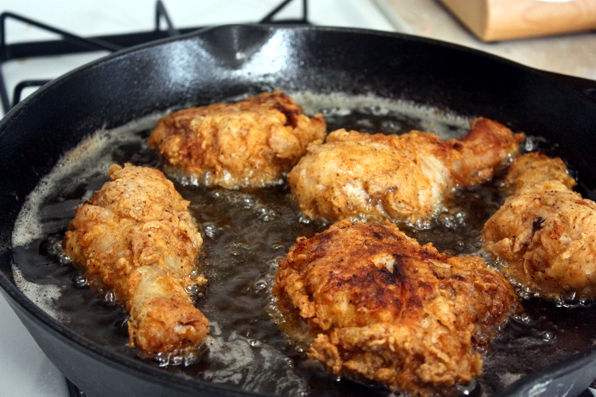Time for another installment in our series on Essential Cooking Techniques. This time we’ll examine the established pantheon of Dry Heat Cooking methods with special attention to that odd place where Moist and Dry Cooking intersect. Hint: Oil and Water don’t mix!
 Frying is a popular method of cooking a wide range of foods. But it’s come
Frying is a popular method of cooking a wide range of foods. But it’s come
under criticism in recent years due to the amount of fat the
food absorbs and transfers to the diner…
Dry Heat Cooking is just that – cooking without Water or steam to transfer heat. So, how does the heat get to the food? You heat the air around it, and the air heats the food. Or you heat the pan under it and the pan heats the food.
Baking
Baking is simply cooking food uncovered in a pan or on a Cookie sheet in an oven. The term is moist often used in reference to Breads and Cakes. Typical oven temperatures for baking range from 350 F to around 400 F.
Roasting
Roasting is similar to Baking, but used exclusively in reference to Meats and Vegetables. The roasting Pan or sheet pan my be covered for part of the cooking time. Typical Roasting temperatures range from 325 F to 425 F.
Searing
This is the process of browning Meat quickly in a pan to achieve Caramelization, or the transformation of the surface Sugars in Meats into a brown, crisp, savoury crust. The Meat is then transferred to the oven to finish cooking. Contrary to popular belief, Searing does not make Meaty more tender or seal in Juices. But it is an indispensable step in creating flavourful attractive Meats. Typical Searing temperatures range from 400 F to 450 F.
Broiling
Broiling is a specialized form of Roasting in which the food is placed close to the top elements in the oven (or, in professional kitchens, under a dedicated Broiling element called a Salamandar) and cooked quickly under high heat. The food cooks and browns in the same step. Typical temperature for Broiling operations is 500 F.
Grilling
Similar to Broiling, but the heat is applied from below, rather than above, and the food is cooked on a metal plate (‘flat top’) or grating. Typical temperatures for Grilling range from 400 F to 500 F.
Smoking
Smoking can be performed in either hot or cold mode. Cold Smoking (see image top of page) is primarily a preservation process which partially dries the food (usually Meat) and is usually performed at a low temperature, just hot enough to keep the wood or wood chips smoking. Hot Smoking is a cooking technique in which food (generally, but not always meat) is slow cooked, at temperatures ranging from 215 F to 250 F, until very tender. Typically, a large cut of Beef or Pork will Smoke for 8 hours or more. In both Cold and Hot Smoking, the aroma and flavours of wood smoke are transferred to the food producing a result that cannot be fully duplicated by any other method. Smoked Meats are usually rubbed with dry herbs and spices or marinated prior to cooking.
And that odd area in the middle…
Ah, yes… Frying techniques use oil in the same way that Moist cooking techniques use water to transfer heat to the food. But, since no water is used, they are technically Dry Heat Cooking methods.
Frying
This popular cooking method uses a small amount of Oil or Fat in a pan to heat to food, usually giving it a Caramelized finish, at least on one side. However, Fried foods are often flipped part way through cooking affording both sides a nicely browned finish. Typical Frying temperatures fall in a range from 350 F to 375 F. Too low and the food just poaches, sucks up the fat and does not crisp. Too high, and it will burn on the outside before cooking through.
Deep Frying
In this technique, foods are immersed in hot Oil for relatively short periods. The Oil is a highly efficient medium to transfer heat to food. Most experienced cooks Deep Fry at 350 F to 365 F. Frying in small batches and waiting between batches for the oil temperature to come back up ensures consistent Crispy results.
Pressure Frying
A method of pressure cooking using hot oil in place of hot water and steam. KFC uses this method of fast-frying to efficiently produce its trademark crispy-on-the-outside, juicy-and-tender-on-the-inside Chicken. Considering that this method uses boiling Oil under pressure to cook the food, it’s not recommended that you try it at home.
And that’s the scoop on Dry Heat Cooking
We’ll be back with more on individual Cooking Techniques as they cone up in the news!
~ Maggie J.

